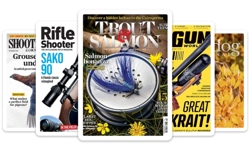Most marketing managers spend testing months and vast mountains of money campaigning to attract consumers to their product. When that product features a pouting bikini-clad model and the consumer is a slavering 18 year-old boy, that’s the easy part. Pity the poor sods sitting round the boardroom table in Nobby’s Nuts HQ wondering how to make the combination of nuts and Noddy Holder appeal to that crucially indifferent 18-30 demographic. For FHM, it’s pretty straightforward: no-nonsense logo – check; generously-proportioned page 3 beauty – check; promise of more of the same inside – check. It’s a wonder the marketing team has to bother promoting the thing at all.
Actually, it’s the very nature of this package that makes it all the more important to spend money marketing FHM at the point of sale. Go into any newsagent in the country these days, and you’ll be assaulted with an array of bra-busting honeys leering at you from the magazine shelves. FHM, Loaded and Maxim have been the stalwarts of the men’s magazine market for a decade now. But, men don’t just do it once a month now (snigger); since the launch of Nuts and Zoo in 2004, it’s every week, every day even if you include the increasing number of scantily-clad girls appearing on the front of the tabloids.
It’s the sheer ubiquity of this material that is the challenge faced by a pioneer like FHM. 10 years ago, it was an entirely different matter. Back in the mid 90s, the idea of a magazine celebrating the sex-obsession and sheer hedonistic stupidity of being a bloke was a unique proposition. Poles apart from the po-faced pontification of a GQ, or the other-worldliness of a Face magazine, FHM and its ilk talked directly to the thousands of beer-drinking, joke-cracking young men across the country. Copies flew off the shelf. Sales efficiencies ran at close to 100%. Newsagents around the country were inundating the FHM office with phone calls crying out for more copies to sell. Sales passed the half-million barrier within a couple of years, and the million mark a couple of years after that. A magazine publisher’s wet dream (a circulation manager’s nightmare!).
Me, me, me
Success breeds imitation, and that’s when the shelves started to groan with me-too magazines lusting after the success of FHM and Loaded. It’s the oldest publishing trick in the book: take a proven formula and recreate it in the cheapest way possible. In the women’s market, giants like Heat had its facsimile in Northern & Shell’s Star magazine and Closer with Natmags’ Reveal. In the men’s market, it was magazines such as Front and ICE that jumped on the bandwagon.
With a magazine distribution chain that pushes hundreds of new launches out to the trade every year, it’s become increasingly difficult for retailers to distinguish between the sure-fire winners and the mediocre. Consequently, on the magazine shelves of most retailers around the country, Front and ICE have shared similar prominence to FHM: the challenge has been to redress this balance in favour of the market-leader.
How this has been achieved on FHM has been through a strategy of communication and support around our key campaigns, with everything designed to maximise awareness to both consumers and the trade.
Circulation shifters
Campaign building on magazines isn’t actually that easy to achieve – there are very few magazines that actually deliver an issue or issues that are genuinely anticipated by the buying public. In the US, there’s Vanity Fair’s legendary "Hollywood" issue, with its gatefold collector’s cover of the movie world’s hot and the great; less well known, but a circulation phenomenon over the pond, is Sports Illustrated’s annual "swimsuit" issue (as tenuous a connection to professional sport as beach volleyball is to the Olympics). Here in the UK, you might look to the Radio Times’ Xmas issue or the annual Q Awards issue as examples of where significant numbers of additional consumers are brought back to the brand, maybe for the only issue that they’ll buy all year. For magazine marketers, these are invaluable sampling opportunities where they can remind consumers of what they do best.
FHM has managed to build three must-have issues into its annual publishing calendar. The longest-running of these (and now a global campaign) is the list of the "100 Sexiest Women in the World". It’s got all the trademarks of a classic magazine campaign: driven by the readers, delivered with class, and generating discussion in both the tabloids and in pubs across the land. It’s this very fact that drives the huge circulation uplift seen on this one issue alone – as a bloke, you simply have to know who’s made it into the top 100, where they were positioned and whether they deserve to be there. Gillian Anderson, at the height of her X-Files fame, was one winner in the late 90s and the furore amongst legions of young men ("a ginger?!") was predictably animated.
More recently, FHM has created another much-aped campaign: FHM "High St Honeys – the UK’s 100 Sexiest Girls-next-door!" As with the "100 Sexiest" issue, it’s driven by reader voting, and now runs for the best part of nine months. Stage one is the recruitment, via the magazine, for nominations; out of the mountains of photos sent, 100 girls are selected and appear in the booklet accompanying the main issue and voted for; finally the campaign is rounded off by the winner appearing on the front cover of a later issue.
With these two circulation-busting promotions, and the stalwart annual calendar issue, the focus of FHM’s trade marketing investment is largely on these three months. In a crowded and noisy magazine environment, it’s crucial that all the stops are pulled out to give these issues the standout they deserve.
In one sense, promoting these issues at retail is pretty straightforward – get the product in front of people and give them a reason to purchase. In reality, there are various financial, creative and logistical considerations that need to be taken into account.
Budgetary constraints
The first of these may come as a surprise to publishers who assume that a multi-million pound brand like FHM probably has vast bundles of cash to throw at promotions like this. In actual fact, like most large media companies these days, every penny has to be justified and accountable, and FHM is selective in where and how its investment is spent. Retailers are prioritized, based on value-for-money, market share and footfall. In other words, there is a dual objective of achieving both awareness and the capacity to shift copies. Copy allocation is critical, as the unit cost of printing each copy of the "100 Sexiest" issue is the highest of any issue published in the year, yet obviously it is important to maximise the opportunity to sell. Assessing exactly what this opportunity is, is a tough challenge in a fickle and unpredictable market.
The creative
The second consideration – the creative execution of the campaign – is the one the most time is probably invested in. Amongst a competitive set who produce their own lists and variations on the planet’s sexiest women, the FHM campaigns have inevitably lost some of their distinctiveness. These magazines are constantly attempting to outdo each other. In one particularly crazy year, FHM’s "100 Sexiest" issue had been preceded the previous month by Loaded’s list of the "Top 101 women in the World", and the month before by Maxim’s "Top 1000!" Publications like Zoo and Nuts produce their own lists on an almost weekly basis.
The challenge for FHM is to emphasise the value of these issues as the definitive article, the daddy of men’s magazines producing the best-quality version. This means a seamless alliance of both product packaging and display. In the past, for example, this has resulted in a fairly minimalist approach on the "100 Sexiest" issue – a simple gold-foil logo against a plain background that says "you know what this issue’s all about, so just buy it". Similarly, the POS display mechanics used have tried to reflect this quality through interesting use of colours (gold/silver/black), materials (mirriboard) and shapes. In 2005, FHM even produced a limited run of ‘jewellery-case’ units, where a copy of the magazine sat on a velvet cushion under a glass case. Eye-catching simplicity is FHM’s key to a successful bit of retail marketing promotion.
Logistics
And finally, the logistics – that word dreaded by most creative professionals. In an average year, FHM will produce around a hundred thousand display units, posters, shelf talkers and DM communication that goes to thousands of different retailers and wholesalers across the country. With that sort of scale, it’s crucial to ensure that enough time is spent on the detail: the production schedule; the robustness of the units; the involvement of every stakeholder before, during and after the campaign and constant communication throughout.
It’s fair to say that FHM has had a lot of success with these campaigns over the years. The big issues are well known and have sold in their hundreds of thousands. It’s also fair to say that times are changing. It’s becoming increasingly difficult to persuade retailers to support these issues in the way FHM would like: most big multiples have stringent barriers to siting FSDUs, branding has to follow corporate guidelines and be acceptable. As you can imagine, this last point is somewhat problematic for a brand that is defined by girls and sex. In grocery, men’s magazines are fighting to stay on the shelves, let alone promote, and it’s through influence and compromise that FHM has stayed in the game.
Luckily, FHM has an arsenal of other marketing tools behind it. FHM.com continues to grow, and now reaches almost two million unique users a month. The FHM brand also extends into TV and mobile, all of which can be used to drive consumers to the magazine. Despite all this, it’s still a long way from the sofa to the shop-floor and, as a pure sales-driver, the retail marketing activity is considered to be the axis of FHM’s key campaigns. That and the parties of course. Night after night of champagne and parades of glamorous girls. Like I said, it’s a long way from marketing Nobby’s Nuts.
FEATURE
POSexy
Take the promise of lots of scantily clad girls and a target market of young men, and you have a fairly simple marketing proposition. Don’t you? Well, not necessarily. Tight budgetary controls, an over crowded category and increasingly censorious retailers have made the task of marketing FHM harder than it once was. Patrick Horton looks at FHM’s POS strategy.










